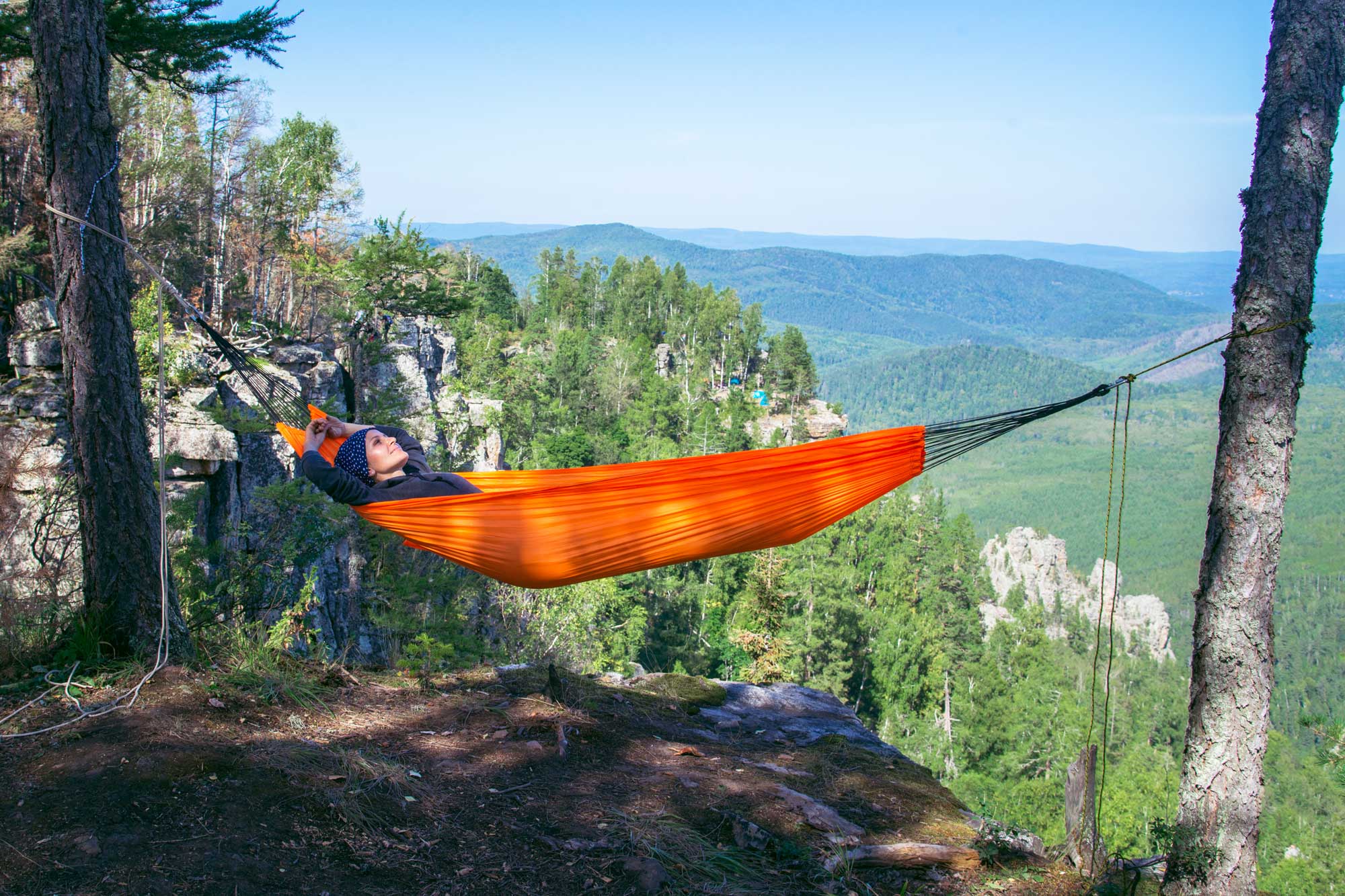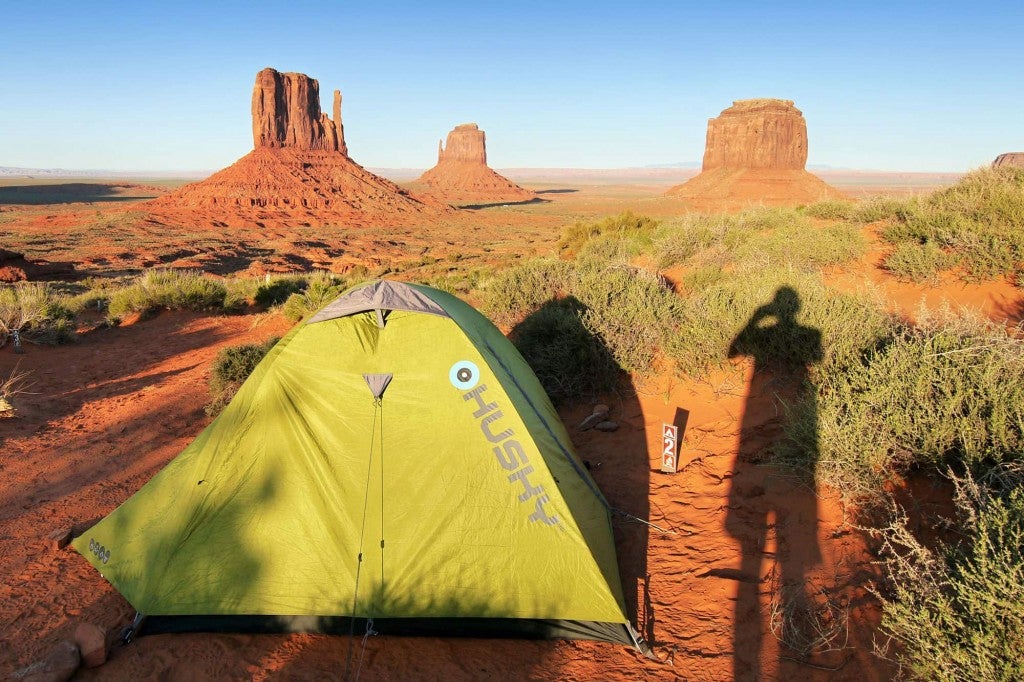Hammock camping is currently enjoying its day in the sun. The development of comfier and more durable camping hammocks has inspired many to ditch their tent and sleep above the ground, instead.
And why not? Is there a better way to relax than gently rocking between two old oak or fir trees in the middle of nowhere? We don’t think so. Hammock camping takes relaxation to a whole new level, but there can be a learning curve when you’re transitioning from tent to hammock. That’s why we’ve collected these 21 hammock camping tips to get you off the ground quicker — and more comfortably.
21 Hammock Camping Tips to Make Your Sleeping Experience Sky High
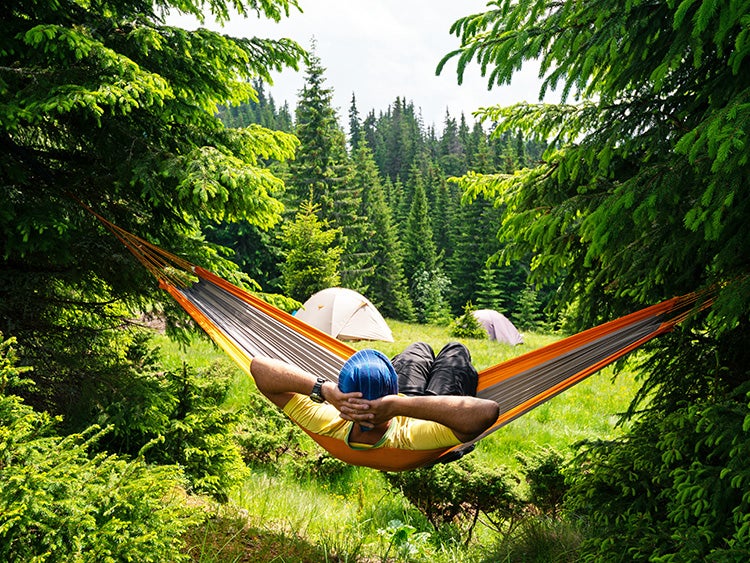
From choosing and stringing up a hammock to staying warm inside one, there are many things to consider when you’re hammock camping for the first time. But our hammock camping tips are useful for first-time campers and seasoned veterans alike.
1. Pick the right hammock
Like all other outdoor gear, hammocks come in all shapes, sizes, materials and qualities. Looking at a shelf of them can be overwhelming because they all look similar, but there are some important differences that set them apart.
There are generally two options for hammocks: one-person and two-person. A one-person hammock will save weight and space in your pack, but a two-person will give you more room to move around and get comfortable. For sleeping, a two-person hammock will offer optimal comfort.
You’ll also want to consider the type of material the hammock is constructed with. The best hammocks are made with a 70D ripstop nylon material to protect against abrasions and offer enough structure to comfortably hold a few hundred pounds.
Consider what you’ll use the hammock for most often. Some hammocks come in full sets with mesh to keep out bugs and tarps to protect from rain. Will you be camping in good weather? Would you want to be out when it’s raining? Or are you looking for a simple camping solution to get you off the ground? If you’re a fair-weather camper just getting started with hammock camping, keep it simple with a two-person, 70D nylon hammock.
In addition, it makes sense to invest in some solid straps for hanging your hammock. Several companies make high-quality webbing straps that can loop around trees of varying sizes and clip to your hammock with a simple carabiner.
2. Choose the right time of year
Camping in a hammock becomes a lot less fun when you choose a suboptimal season to camp. While the hardcore enthusiasts might say you can camp year-round in a hammock, we are not those people. Check to make sure that temperatures won’t drop into the 30s or 40s during the night and that precipitation chances are low since you won’t have a place to retreat or a partner to snuggle.
Try hammock camping at the start of summer once the weather evens out to sunny days and warm nights.
3. Bring a tent on your first outing
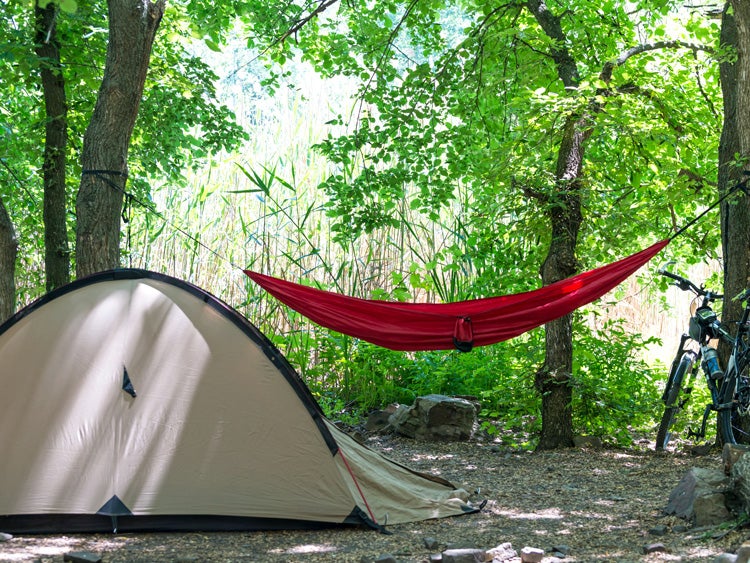
Anytime you try a new method, it’s important to have a backup. Sleeping in a hammock can feel like you’re being rocked into dreamland, but sometimes you don’t quite get the correct setup and it’s almost impossible to fall asleep. (Our hammock camping tips below will help with that, though.)
4. Pick trees that are well spaced
Is this one of the more obvious hammock camping tips? Yes. Is it also one of the easiest to forget about? Absolutely. Your hammock stretches farther than you might assume. Pick trees that are pretty far apart from one another so you can tautly hang your hammock. The tighter your hammock, the better when you’re trying to make a bed for the night. This way there will be less sag and ultimately more comfort, similar to how your bed at home might feel.
5. Use momentum to anchor your straps

Picking thick, sturdy trees has one potential major downfall: it can be nearly impossible to reach your arms around the trunk to attach the anchor straps. Wind up a little bit to get momentum on your side as you lasso the strap around the tree. Yes, it will look like you’re hugging the tree, but it’ll work.
Once you have a strap in each hand on either side of the tree, thread the fixed end through the looped end and ratchet it down as tightly as possible. Use a carabiner to attach your hammock to one of the loops of the anchor straps and repeat on the opposing tree.
6. Protect against potential hazards
When picking trees to string your hammock from, make sure you’re not in a danger zone. Pick thick, live trees that won’t bend or break once you sit in your newly strung hammock. Also, make sure to take a look above: Are there branches hanging in the canopy that only need a good shake or two to come tumbling down? If so, choose another location.
Checking for minor hazards like ant mounds and beehives will also prevent some run-ins with insects that would make for a less-than-ideal hammock camping experience.
7. Set up at least 200′ from water

In keeping with Leave No Trace ethics, set up your hammock at least 200’ from any water source. Not only is this one of the best hammock camping tips, this should be followed on nearly every camping trip.
8. String your hammock with room to sag
This is one of the best hammock camping tips to remember when you’re first getting it set up. While you want a taut line when it’s time to sleep, a little more give when you try to get cozy with a good book or take in the views will be far more comfortable than the tight cocoon you made for sleeping.
Most hammocks come with a daisy chain on the straps for multiple height adjustments. To allow your hammock a little more give, simply bump the carabiner down a few notches to relax. Move it back up when it’s time to call it a night.
9. Sitting in a hammock vs. sleeping in a hammock
When you’re not settling in for the night, it’s more comfortable to allow the hammock to sag like mentioned in our previous tip and it’s also far more comfortable to sit in the hammock like a chair so you’re perpendicular to the hammock instead of horizontal inside of it. This way, one side of the hammock acts as your back and neck support as your feet drape off the other side like a chair.
For this reason, the hammock is a great alternative for backpacking because it gives you both a bed and a chair in one piece of gear.
10. Find your comfy sleeping position
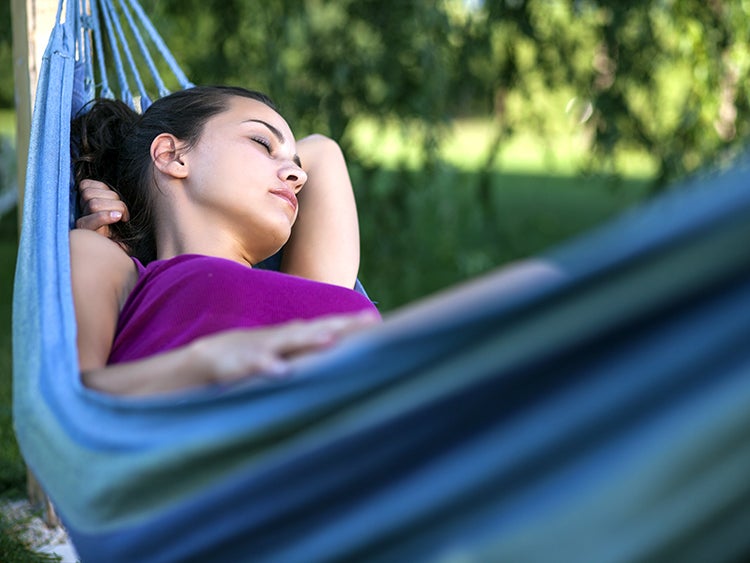
Sleeping in your hammock might take some getting used to. Sleeping on your stomach is a no-go unless you want to wake up with a screaming backache. Typically sleeping on your back or your sides will be the most comfortable. Add blankets and pillows to turn the hammock into a replica of your bed at home — and to stay as warm as possible.
It might take some shifting and maneuvering to figure out the best position for you and your body.
11. Stay warm with an underquilt and sleeping pad
This is one of the most important hammock camping tips for the winter, or in colder climates in general. Air circulates freely beneath a suspended hammock. Without a sleeping pad or underquilt, your body is in near direct contact with the cold air surrounding you. Adding a sleeping pad helps tremendously, with both warmth and comfort.
If the night is particularly cold, add an underquilt to your hammock to create warmth beneath you and prevent drafts from reaching your body. An underquilt helps most during colder nights, but it’s also a great addition for windier campsites.
12. Wear layers while you sleep
Just like you would if you were sleeping in a tent, sleeping in layers helps keep you warm and cozy throughout the night. And with your face exposed to the elements and the possibility of a draft in your sleeping bag, you’ll want to at least have a base layer on to keep nice and toasty through the night.
13. Hang a tarp to stay dry
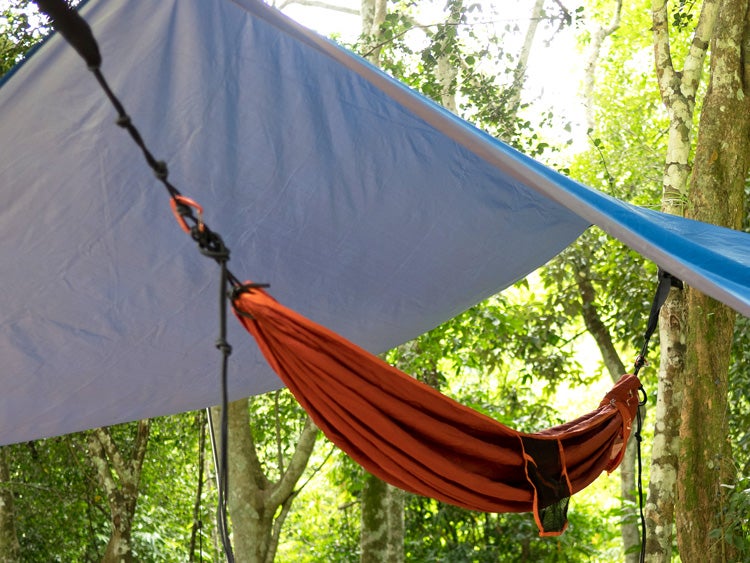
That guyline that’s organizing all your gear? It can serve double duty as a rain fly. Simply drape a tarp over the guyline and tether each end of the tarp down to the ground with additional guylines and four tent stakes.
You don’t have to stretch the tarp out to all four points, but doing so will keep the precipitation moving away from you and give you a little more space and air to breathe.
Or you can opt a hammock tent that comes with its own cover.
14. Invest in mesh to keep the bugs out
This might be one of the more obvious hammock camping tips, but always remember to set up mesh before you fall asleep — otherwise you’ll wake up eaten alive. You can jimmy-rig a closed hammock system by using binder clips to connect the opening of your hammock, or you can invest in a mesh system to cover the entire hammock. The benefit of a closed mesh system is that it allows you to rest in your hammock or read a book with air circulation but no pestering from summertime insects.
15. Try stringing two hammocks from one tree
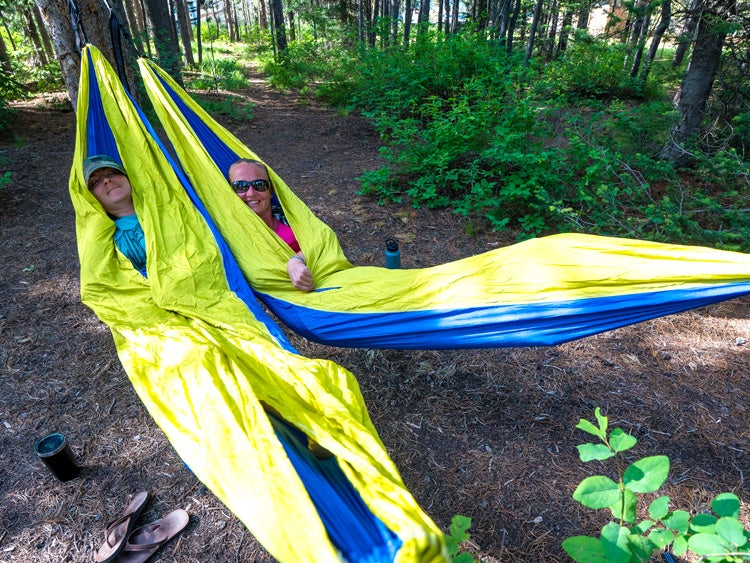
Chances are, you won’t be hammock camping alone. If that’s the case, there may only be a few trees that are available to string your hammock from. Even worse, there may only be two trees to hang multiple hammocks from.
If you want to string two hammocks from one tree, you can do so by stacking them. Make sure you have plenty of space between each of the hammocks so that when you each pile in, the hammocks don’t sag on top of each other.
Or you can opt for the Fuse Tandem Hammock System from ENO, which parallels two hammocks using one set of anchor points. It’s a great option for keeping your camp mates close while maintaining your personal space.
16. Use a guyline to store your stuff
Without a tent, it’s not as easy to store your belongings. If you’re car camping, this is less of an issue – just keep your goods in the car. But if you decide to go hammock camping in the backcountry, there are fewer options for keep your bag off the ground and away from critters. Tying a guyline either above or below your hammock with a series of loops gives you plenty of attachment points to store your gear.
Alternatively, you can use a carabiner to attach to one of the anchor points between your hammock and tree to elevate your gear or backpack.
17. Trick out your hammock camping setup with accessories
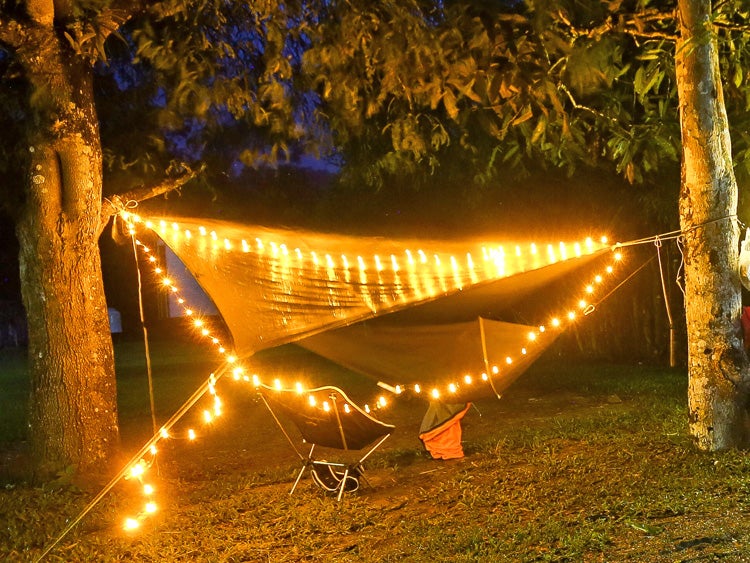
Not all hammock camping tips should focus on the bare basics! With the rising popularity of hammock camping, there are now dozens of accessories you can add to your hammock setup to make it even cozier. There are string lights to hang above the hammock for ambiance, pouches to keep smaller items close by, and portable stands in case you camp in an area where there aren’t enough trees.
18. Keep it light
For backpackers, one great benefit to hammock camping is how lightweight you can keep your setup. Hammocks themselves generally clock in right around a pound; it’s the added accessories that can up the weight. Consider what you actually need and what you can do without to keep your setup as light as possible.
19. Remove your hammock when you leave
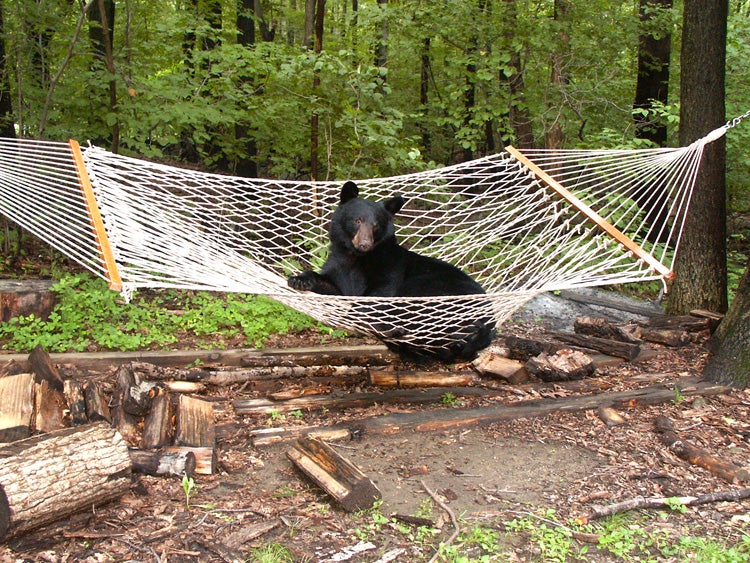
Plenty of campers leave their hammocks strung if they leave the campsite for a while, but doing so will not only allow leaves and dirt to accumulate in the hammock, but it also adds an additional trap for wildlife or children.
Since hammocks are generally strung between two carabiners, they’re easy to string up and take down. This one minor consideration could reduce the likelihood of a run-in with a critter or creature that you didn’t intend.
20. Easily clean sap off anchor straps
Inevitably, once you wrap your straps around a few trees you’ll end up with sticky sap on your straps — and maybe even yourself. So how do you remove this small nuisance? Any alcohol-based hand sanitizer does the trick. Make sure to test a small section of your hammock first and then apply generously to the sap, working it in to release the sap’s grip on your hammock straps.
This is one of the more multi-use hammock camping tips; the hand sanitizer trick also works for clothing and gear to prevent tree sap from destroying everything you brought on your camping trip.
21. Clean your hammock regularly to increase longevity
This might be one of the most important hammock camping tips because it can be so easy to forget — dirt build-up can slowly eat away at your gear. That’s why washing your hammock on a semi-regular basis will keep it fresh and ready to use for years to come. It’s easy, too. Remove the carabiners and add the hammock to a front-loading washer. Add mild detergent, wash with cold water on the delicate cycle, then line dry.
The Dyrt is the only camping app with all of the public and private campgrounds, RV parks, and free camping locations in the United States. Download now for iOS and Android.Popular Articles:
Articles on The Dyrt Magazine may contain links to affiliate websites. The Dyrt receives an affiliate commission for any purchases made by using such links at no additional cost to you the consumer.

